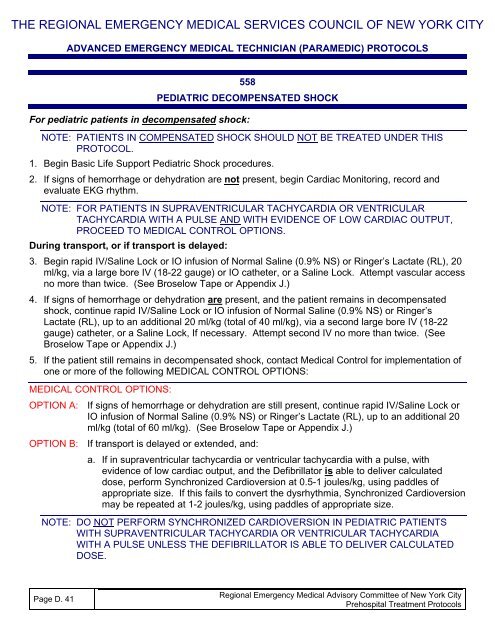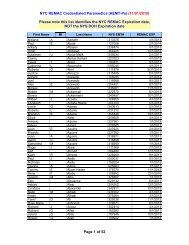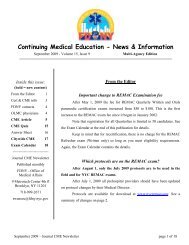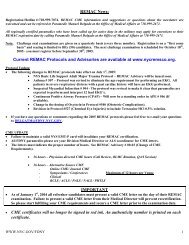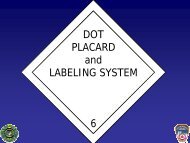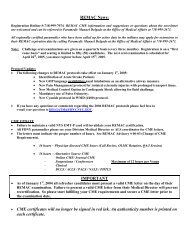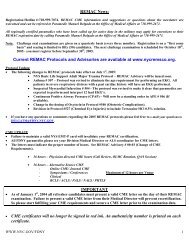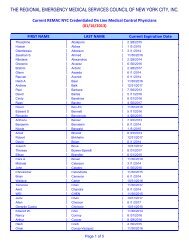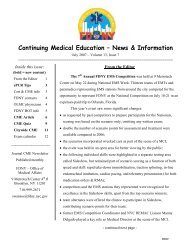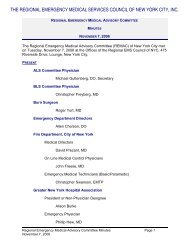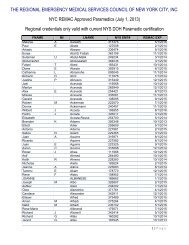prehospital treatment protocols - The Regional Emergency Medical ...
prehospital treatment protocols - The Regional Emergency Medical ...
prehospital treatment protocols - The Regional Emergency Medical ...
Create successful ePaper yourself
Turn your PDF publications into a flip-book with our unique Google optimized e-Paper software.
THE REGIONAL EMERGENCY MEDICAL SERVICES COUNCIL OF NEW YORK CITYADVANCED EMERGENCY MEDICAL TECHNICIAN (PARAMEDIC) PROTOCOLS558PEDIATRIC DECOMPENSATED SHOCKFor pediatric patients in decompensated shock:NOTE: PATIENTS IN COMPENSATED SHOCK SHOULD NOT BE TREATED UNDER THISPROTOCOL.1. Begin Basic Life Support Pediatric Shock procedures.2. If signs of hemorrhage or dehydration are not present, begin Cardiac Monitoring, record andevaluate EKG rhythm.NOTE: FOR PATIENTS IN SUPRAVENTRICULAR TACHYCARDIA OR VENTRICULARTACHYCARDIA WITH A PULSE AND WITH EVIDENCE OF LOW CARDIAC OUTPUT,PROCEED TO MEDICAL CONTROL OPTIONS.During transport, or if transport is delayed:3. Begin rapid IV/Saline Lock or IO infusion of Normal Saline (0.9% NS) or Ringer’s Lactate (RL), 20ml/kg, via a large bore IV (18-22 gauge) or IO catheter, or a Saline Lock. Attempt vascular accessno more than twice. (See Broselow Tape or Appendix J.)4. If signs of hemorrhage or dehydration are present, and the patient remains in decompensatedshock, continue rapid IV/Saline Lock or IO infusion of Normal Saline (0.9% NS) or Ringer’sLactate (RL), up to an additional 20 ml/kg (total of 40 ml/kg), via a second large bore IV (18-22gauge) catheter, or a Saline Lock, If necessary. Attempt second IV no more than twice. (SeeBroselow Tape or Appendix J.)5. If the patient still remains in decompensated shock, contact <strong>Medical</strong> Control for implementation ofone or more of the following MEDICAL CONTROL OPTIONS:MEDICAL CONTROL OPTIONS:OPTION A: If signs of hemorrhage or dehydration are still present, continue rapid IV/Saline Lock orIO infusion of Normal Saline (0.9% NS) or Ringer’s Lactate (RL), up to an additional 20ml/kg (total of 60 ml/kg). (See Broselow Tape or Appendix J.)OPTION B: If transport is delayed or extended, and:a. If in supraventricular tachycardia or ventricular tachycardia with a pulse, withevidence of low cardiac output, and the Defibrillator is able to deliver calculateddose, perform Synchronized Cardioversion at 0.5-1 joules/kg, using paddles ofappropriate size. If this fails to convert the dysrhythmia, Synchronized Cardioversionmay be repeated at 1-2 joules/kg, using paddles of appropriate size.NOTE: DO NOT PERFORM SYNCHRONIZED CARDIOVERSION IN PEDIATRIC PATIENTSWITH SUPRAVENTRICULAR TACHYCARDIA OR VENTRICULAR TACHYCARDIAWITH A PULSE UNLESS THE DEFIBRILLATOR IS ABLE TO DELIVER CALCULATEDDOSE.Page D. 41<strong>Regional</strong> <strong>Emergency</strong> <strong>Medical</strong> Advisory Committee of New York CityPrehospital Treatment Protocols


